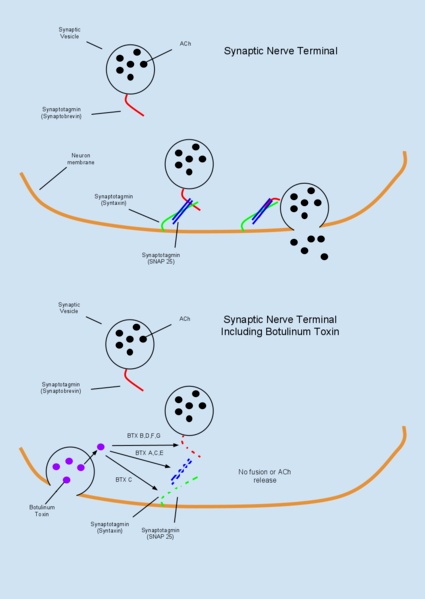Botox; More Than Just Looks
- Joanne Lee
- Aug 5, 2020
- 3 min read
By Jason Luo
Many people have heard of Botox injections, a widely used treatment that reduces the appearance of wrinkles on a person's face and makes one's appearance younger. While Botox injections are fairly well known amongst the public, not many people know how the injection actually works and its other uses in medicine and treatments. This article will discuss the origins, effects, and other applications of botulinum toxin, the main chemical used in Botox injections.
Botulinum toxin is a neurotoxic protein produced by the bacteria Clostridium Botulinum (C. Botulinum). This bacteria thrives in anaerobic, basic environments and grows in food that is improperly processed such as canned beans. C. Botulinum can create several types of botulinum toxin (types A-G) but only types A, B, E, and F are dangerous to humans. In terms of its structure, botulinum toxin starts out as a single polypeptide chain that is then transformed into an active neurotoxin through the bacteria’s metabolic processes. The final protein contains an additional light and heavy chain that are linked by noncovalent protein-protein bonds and a disulfide bridge formed from the sulfhydryl functional groups on the protein's backbone.
When injected into the body, botulinum toxin acts as a inhibitor in the nervous system by blocking the release of the neurotransmitter acetylcholine (Ach). Acetylcholine activates various responses in the body such as contracting smooth muscles, dilating blood vessels, slowing down heart rate, and increasing secretion of bodily fluids.
In particular, type A and type B botulinum toxin are what affect humans the most. They block a particular protein in motor neurons called SNARE (soluble N-ethylmale-imide-sensitive factor-attachment protein receptors). When functioning properly, SNARE facilitates the release of neurotransmitters by allowing intracellular vesicles that carry neurotransmitters to bind and fuse with the cell membrane in the presynaptic neuron. The vesicles are then released via exocytosis and the neurotransmitter would bind to a postsynaptic neuron to carry out a response. By preventing this release, botulinum toxin can lessen or inhibit the effects of acetylcholine that it normally carries out. In Botox injections, the use of the toxin causes the wrinkles on a person's face to lessen as the inhibition of acetylcholine prevents specific face muscles from contracting. Botulinum toxin can also inhibit the release of other neurotransmitters that depend on SNARE such as glutamate.

One of the main effects of botulinum toxin is that it can cause botulism, an illness where the muscles in the body undergo paralysis and can no longer contract. This can lead to many symptoms such as muscle weakness, trouble breathing/swallowing, and trouble speaking as certain muscles in the body cannot move properly. Death can occur from botulism mainly due to muscles like the lungs being unable to take in oxygen correctly and efficiently. Babies are affected more with symptoms that include constipation and having a “floppy” appearance due to poor muscle tone. Botulinum toxin is also one of the most toxic poisons known to man, with very minute amounts of it being capable of killing an average person. Specifically, 30 nanograms of the toxin can kill a human if ingested orally, 0.8-0.9 micrograms if inhaled, and .09-.15 micrograms if injected into a person’s veins. This is why Botox injections, along with other treatments using botulinum toxin, use minuscule amounts of the toxin and it is also why multiple injections of the treatment is highly discouraged.
Despite the high potency of the toxin, botulinum toxin has a wide variety of uses aside from Botox injections. Many of the uses involve injections of botulinum toxin into certain muscle groups to prevent the release of acetylcholine and thus prevent the contraction of these muscles. Cervical dystonia, a condition where the neck muscles contract, tilt, and turn involuntarily, is treated with small doses of botulinum toxin into particular muscle groups in the neck. Urinary symptoms caused by an overactive bladder (OAB) can be treated through botulinum toxin being injected directly into the bladder tissue in order to relax the muscles responsible for excessive urination. Finally, blepharospasm and strabismus, conditions involving uncontrollable blinking and cross eyed vision respectively, can be treated with botulinum toxin injections into muscle groups near the eyes.

Citations:
Image Credit:




Comments